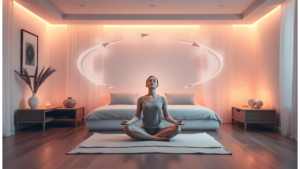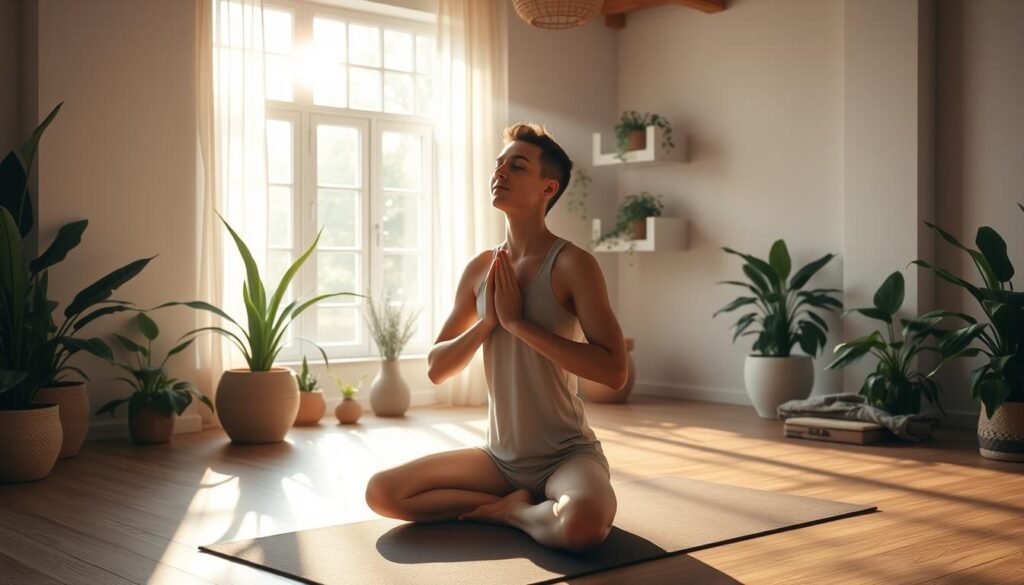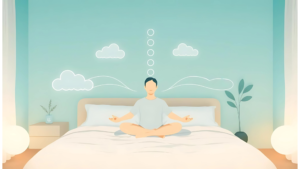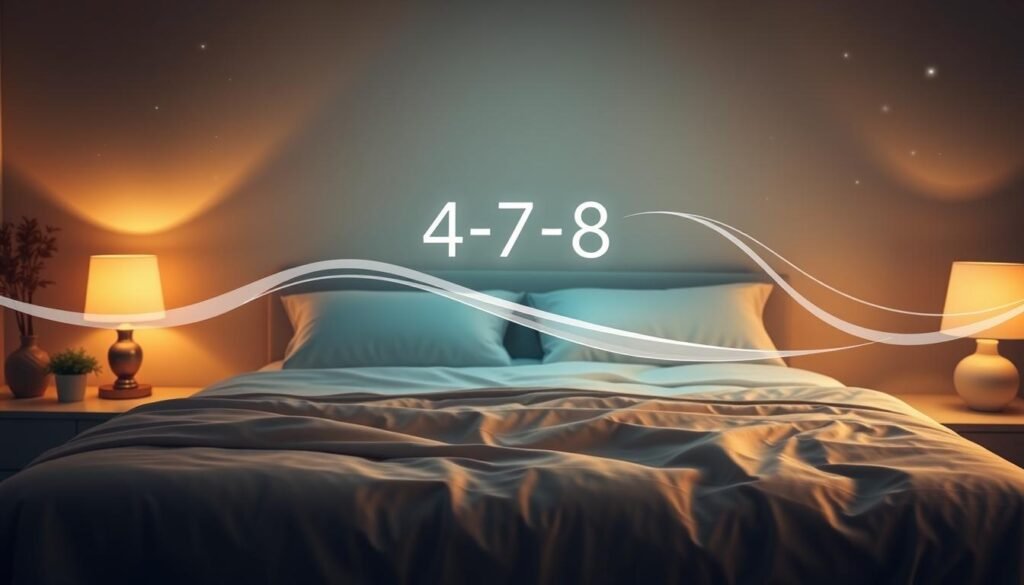Having trouble falling asleep? A simple breathing technique can help you relax and sleep better. The 4-7-8 breathing method is an ancient yogic practice. It involves breathing in for four seconds, holding for seven, and exhaling for eight.
While there’s not much scientific research, many people find it relaxing. It can help you fall asleep faster. You can do it sitting or lying down. Just place your tongue behind your teeth and breathe as instructed.
The 4-7-8 technique is easy to learn. It slows down your breathing and activates your body’s rest mode. This can lower stress, anxiety, and pain, leading to better sleep.
Key Takeaways
- The 4-7-8 breathing technique involves inhaling for 4 seconds, holding the breath for 7 seconds, and exhaling for 8 seconds.
- This ancient yogic practice can help combat insomnia, anxiety, and depression.
- Consistent practice of the 4-7-8 technique can improve your resilience to daily stressors.
- The technique may help release oxygen into the body and optimize the oxygenation process.
- Regular practice of the 4-7-8 breathing can provide lasting benefits for reducing anxiety.
Understanding the Science Behind Breathing for Sleep
Mindfulness meditation, deep breathing, and pranayama yoga can greatly improve sleep. They work by controlling our breathing. This affects our nervous system and body functions.
The Role of Breath in Sleep Regulation
The 4-7-8 breathing method was popularized by Dr. Andrew Weil in 2015. It has roots in yoga’s pranayama. You breathe in for four counts, hold for seven, and breathe out for eight.
This pattern helps calm the nervous system. It reduces stress and anxiety.
How Controlled Breathing Affects the Nervous System
The 4-7-8 technique lowers heart rate and blood pressure. It helps you relax and sleep better. Doctors suggest doing it twice a day for best results.
Connection Between Breathing and Sleep Quality
Using the 4-7-8 breathing method before bed can improve sleep. It also boosts focus and mindfulness. This helps you stick to the rhythm and make it a daily habit.

“Slow, controlled breathing can influence autonomic function and pain processing/perception, according to research.”
What is the 4-7-8 Breathing Technique
The 4-7-8 breathing technique is a calming technique and breathwork therapy. It helps manage anxiety and improves sleep. This method uses a specific breathing pattern to relax the body deeply.
Here’s how the 4-7-8 breathing technique works:
- Exhale completely through your mouth, making a “whoosh” sound.
- Inhale quietly through your nose for a count of 4 seconds.
- Hold your breath for a count of 7 seconds.
- Exhale forcefully through your mouth for a count of 8 seconds, making another “whoosh” sound.
Repeat this cycle up to 4 times. Keep the 4:7:8 ratio, adjusting seconds for comfort.
This technique activates the parasympathetic nervous system. It helps the body relax and improves oxygen flow to organs and tissues.
| Breathing Technique | Inhale | Hold | Exhale |
|---|---|---|---|
| 4-7-8 Breathing | 4 seconds | 7 seconds | 8 seconds |
Regular practice of the 4-7-8 breathing technique can help control anxiety and stress. It also improves sleep quality. By adding this breathwork therapy to your daily routine, you can enjoy better relaxation and well-being.

“Deep breathing exercises, such as the 4-7-8 breathing technique, can lower heart rate and blood pressure when the body is under stress, potentially reducing strain on the heart.”
Origins and Development of Pranayama Breathing
The 4-7-8 breathing technique comes from pranayama, an old yogic practice of controlling breath. Dr. Andrew Weil, an American doctor, made it modern. Some studies show it helps with heart health, stress, and pain.
Ancient Yogic Roots
Pranayama, or controlling breath, is key in yoga and meditation for ages. It uses breath to improve body, mind, and spirit. The 4-7-8 method is based on these ancient breathing exercises.
Modern Medical Adaptations
In the 1990s, Dr. Andrew Weil introduced the 4-7-8 breathing. He made it simple for today’s busy lives. It’s a way to practice mindfulness meditation and deep breathing exercises for stress and better sleep.
Scientific Research and Validation
Research on the 4-7-8 breathing is still growing. Yet, studies show it’s beneficial. A 2020 review found it can improve heart and lung health, lower blood pressure, and help with chronic conditions. Recent studies in 2022 and 2023 suggest it can also help with heart rate, blood pressure, and anxiety.

“Breathing is the foundation of life, and conscious breath control can have a profound impact on our physical, mental, and emotional well-being.”
| Potential Benefits of 4-7-8 Breathing | Scientific Evidence |
|---|---|
| Reduced test anxiety in college students | A study of college students showed that practicing pranayama reduced test anxiety. |
| Decreased anxiety in senior citizens | Another study of senior citizens showed decreased anxiety after two months of deep breathing exercises. |
| Lowered blood pressure and heart rate | Slow deep breathing for five minutes has been shown to reduce blood pressure and heart rate in people who practice it. |
| Reduced pain perception | A study of 16 healthy people found that those who practiced relaxed deep breathing experienced less pain than those who practiced deep breathing that required a lot of sustained attention. |
| Improved attention and reduced negative emotions | A 2017 study examined the effect of eight weeks of deep, slow, abdominal breathing on attention, emotions, and stress levels. After training, the people in the deep breathing group performed better on tests of attention and had fewer negative emotions. |
Step-by-Step Guide to Perfect 4-7-8 Breathing
Learning the 4-7-8 breathing technique is easy and powerful. It helps with relaxation breathing for better sleep and less stress relief and anxiety management. Dr. Andrew Weil made it famous with its unique breathing pattern.
First, sit or lie down comfortably. Put your tongue on the roof of your mouth, just behind your teeth. Then, breathe out fully through your mouth, making a “whoosh” sound.
- Breathe in quietly through your nose for 4 seconds.
- Hold your breath for 7 seconds.
- Finally, breathe out fully through your mouth for 8 seconds, making another “whoosh” sound.
Do this cycle for 4 breaths. Practice it twice a day for the best results.
When you start, you might feel a bit dizzy. If it’s uncomfortable, stop and drink water. Soon, your body will get used to it, and you’ll enjoy the many benefits of this relaxation breathing method.

“The 4-7-8 breathing exercise can be a powerful tool for managing stress and anxiety. By slowing down your breath and focusing on the counting, you activate the parasympathetic nervous system, which is responsible for resting and digesting.”
Adding the 4-7-8 technique to your daily routine can change your life. It’s all about being consistent. Make it a habit and feel the amazing effects of this simple yet powerful breathing exercise.
Health Benefits of Regular Practice
Adding the 4-7-8 breathing technique to your daily routine can bring many health benefits. It can improve your heart health and help reduce stress and anxiety. This simple exercise can greatly improve your overall well-being.
Cardiovascular Improvements
Using the 4-7-8 breathing technique regularly can improve your heart health. A 2022 study found it can boost heart rate variability and lower blood pressure in young adults. This can lead to a healthier heart by increasing blood oxygen and reducing heart work.
Stress and Anxiety Reduction
If you’re feeling stressed or anxious, this breathing technique can help. A 2023 study showed it can lessen anxiety symptoms and improve life quality. Just 5 minutes of slow breathing can lower stress and anxiety, as a recent study found.
Blood Pressure Management
The 4-7-8 breathing technique can also help manage blood pressure. A 2022 study found it improves heart rate variability and blood pressure in healthy young adults. It promotes emotional stability and helps regulate the nervous system, leading to healthier blood pressure.
Adding the 4-7-8 breathing technique to your daily routine can greatly improve your health. It can reduce stress and anxiety and enhance heart function. Regular practice of this simple exercise can have a significant positive impact on your life.
Common Mistakes to Avoid During Practice
Practicing the 4-7-8 breathwork therapy technique can help you relax and calm down. But, there are mistakes to avoid to get the most out of it. Let’s look at some common errors to steer clear of during your 4-7-8 breathing sessions.
- Incorrect tongue placement: Make sure the tip of your tongue is gently against the ridge behind your upper front teeth.
- Inconsistent breathing ratios: Stick to the 4-7-8 ratio, adjusting the seconds if needed.
- Shallow breathing: Take deep, diaphragmatic breaths. Let your belly expand on inhale and contract on exhale.
- Tensing muscles: Keep your body relaxed and free of tension during practice.
- Practicing too frequently: Start with 4 complete breath cycles and increase as you get more comfortable.
- Expecting immediate results: Remember, the benefits of 4-7-8 may take time with daily practice.
Avoiding these common mistakes will help you get the most from your 4-7-8 breathwork therapy sessions. This way, you can unlock the full potential of this powerful calming technique for relaxation breathing.
“Proper breathing techniques can significantly enhance both physical and mental well-being.”
Incorporating 4-7-8 Breathing into Your Bedtime Routine
The 4-7-8 breathing technique can be a great addition to your bedtime routine. It helps you relax deeper and sleep better. This ancient yogic practice calms the mind and body, making it a top choice for stress relief.
Optimal Timing for Practice
For the best results, practice the 4-7-8 breathing 1-2 hours before bed. It prepares your body and mind for a good night’s sleep. Make it a regular part of your bedtime routine.
Creating a Suitable Environment
To get the most out of the 4-7-8 breathing, create a calm space. Dim the lights and avoid distractions. Adding aromatherapy or white noise can enhance the experience.
Adding the 4-7-8 breathing to your bedtime routine can greatly improve your sleep. It’s a simple yet powerful way to manage anxiety and promote well-being. Spend a few minutes each night to enjoy its benefits.
Supporting Practices for Better Sleep
Using the 4-7-8 breathing technique is just the start. You can also add other practices to your bedtime routine. These can make your sleep even better. They help you relax and get a good night’s rest.
Optimize Your Sleep Environment
Make your bedroom a sleep haven. Use a mask to block out light and a white noise machine for sound. Earplugs can also help block out noise. Playing calming music can also help you relax before bed.
Embrace Aromatherapy
Essential oils like lavender can calm your mind and body. Use a diffuser to spread these scents in your room. They can help you feel more relaxed and ready for sleep.
Limit Caffeine and Screen Time
Less caffeine in the afternoon and evening helps you sleep better. Also, avoid screens before bed. The blue light they give off can mess with your sleep cycle.
Incorporate Gentle Bedtime Yoga
Doing gentle yoga before bed can relax you. Try poses like forward folds and child’s pose. They help release tension and prepare you for sleep.
Adding these practices to the 4-7-8 breathing can make a great sleep routine. Try different things to see what works best for you. Enjoy better sleep quality.
| Supporting Practice | Benefits |
|---|---|
| Wearing a sleeping mask | Blocks out disruptive light for better sleep |
| Using a white noise machine | Creates a consistent sound environment to promote relaxation |
| Wearing earplugs | Reduces external noises that can interrupt sleep |
| Diffusing essential oils | Provides calming aromatherapy benefits for better sleep |
| Limiting caffeine intake | Helps the body relax and prepare for sleep |
| Practicing bedtime yoga | Promotes physical and mental relaxation for improved sleep |
“The 4-7-8 breathing technique can be particularly helpful for eczema caregivers, who often experience high levels of stress, providing them with a tool for managing their well-being.”
– Dr. Olivia Hsu Friedman, Doctor of Acupuncture and Traditional Chinese Medicine
Conclusion
The 4-7-8 breathing technique is a simple yet powerful tool for better sleep and stress relief. Many people have seen great benefits from using it every day. More research is needed to fully understand its effects.
Being patient and consistent is crucial when starting the 4-7-8 technique. Adding it to your bedtime routine can help you relax and reduce stress. It’s a simple way to improve your well-being.
If you still have trouble sleeping, talk to a healthcare professional. They can help find the cause and suggest more treatments. Using the 4-7-8 technique along with other practices can lead to better sleep and health.



